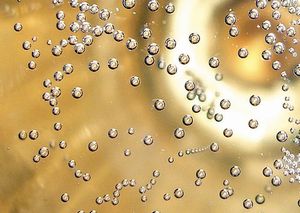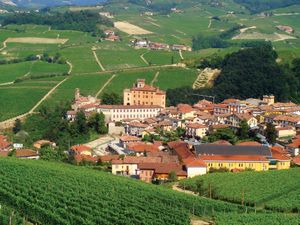Chianti is filled with a variety of sub-zones, each with its own characteristics and distinguishing qualities. The Chianti Rufina area, located in the Levante Fiorentino just east of Florence, is known for its aromatic and fruity wines with higher acidity and firmer, less evolved tannins. The proximity of the Apennine mountains allows for a greater day/night temperature variation, which deepens the color of young Rufina wines and further strengthens their acidity. As early as 1716, Cosimo III de’ Medici proclaimed that the region containing the modern day Chianti Rufina was one of the four best in the area. More recently, the region has produced some of the best wines in all of Tuscany. One of the most fascinating wineries in the area is the Castello del Trebbio, an estate that dates back to the twelfth century as the former home to the Pazzi family. The highly respected wine rating entity Gambero Rosso (GR) notes that the 2003 Pazzesco—made from Sangiovese, merlot, and syrah grapes—was solid and well balanced. It also regards the Lastricato Chianti Rufina Riserva as well worth attention.
Though the Azienda Agricola Travignoli occupies a slightly larger land area than Castello del Trebbio, it produces only 250,000 bottles compared with the latter’s 340,000 bottles. Travignoli was formed in the twelfth century and has been run by the Busi family since the 1700s. Experts agree that the winery works hard to give good value for the money and has been continuously improving its overall level of production. Travignoli produces almost exclusively Chianti Rufina and Chianti Rufina Riserva.
Despite the company’s enormous size, the wineries of the Marchesi de’ Frescobaldi are known for the care they give to each of their estates, carefully taking into account the different climatic characteristics and terrains of each. GR notes that the Chianti Rufina Nipozzano Riserva 2004 is enjoyable and well-made, even though more than one million bottles of it were produced. The Montesodi is also considered one of the area’s finest wines.
Although Tuscany is not well known for its white wines, the producers east of Florence make some interesting whites. Pomino is one of the smallest DOC regions in Italy. The 2008 edition of GR found the Frescobaldi’s 2005 Pomino Benefizio, made from chardonnay grapes, austere and full-bodied, while the 2006 was more fresh and flavorful.
Equally ancient as Trebbio—with Etruscan and Roman ties—is the Fattoria di Altomena. The Porto Rubino Chianti is made from 100 per cent Sangiovese grapes, while the Oenant Chianti Riserva opts for 10 percent Cabernet Sauvignon. Located about 12.5 miles south-east of Florence, near Pelago, this farm has devoted itself to producing high quality wines since 1995. Not only are the grapes hand-picked at harvest, but during July and August many grape clusters are removed so that the harvest per plant remains low while ensuring optimum quality.
On the other end of the spectrum from Frescobaldi’s nine million bottles, are smaller estates such as the Fattoria Lavacchio. Owned and operated by the Lottero family, this organic winery produces approximately 100,000 bottles from their 49.4 acres of vines. Once known primarily for its Oro del Cedro Traminer Aromatico—an aromatic, sweet wine made entirely from late-harvested traminer grapes—the winery has received significant recognition recently for its Pachar IGT Toscana bianco (70 percent chardonnay, 20 percent viognier and 10 percent sauvignon blanc) and its ‘generic’ red, Fontegallli. GR found the latter—a blend of merlot, Sangiovese, and cabernet sauvignon—to be ‘well rounded and consistent’.
Finally, many producers in Pontassieve, Dicomano, Pelago, Rufina and other areas in the Levante Fiorentino make a Tuscan wine traditionally served at the end of a meal, the Vin Santo. This sweet wine is made from a blend of trebbiano and Malvasia grapes, which, after harvesting, are hung until nearly dried out, then pressed and fermented. After the initial fermentation, the barrels are sealed for up to ten years, allowing the wine to acquire a deep, golden color and a very sweet taste.
Fattoria di Altomena – www.altomena.it
Castello del Trebbio – www.vinoturismo.it
Marchesi dè Frescobaldi – www.frescobaldi.it
Fattoria Lavacchio – www.fattorialavacchio.com
Azienda Agricola Travignoli – www.travignoli.com








